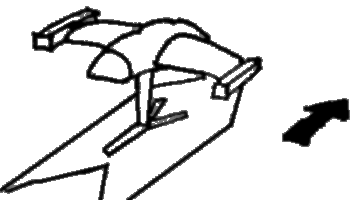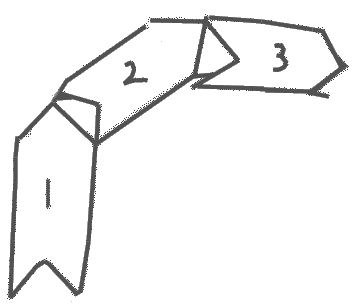
Energy Blocks are central to ship design. Blocks are lost due to combat. There is also a risk every turn that Blocks will just "burn out" (the risk is higher for ships using higher energy levels). When a fighter has no more Blocks, it shifts to emergency power and must head for the table edge which it entered play from (it has no more offensive power). If a ship takes sufficient damage for it to have a "negative" amount of Blocks, it is destroyed.
Unlike Blocks, which are purchased in numbers from 1 to 7, the other elements of spacecraft design -- guns, armour, and engines -- come in only two amounts: standard and surplus. For instance, all fighters come with a standard allotment of lasers. Purchasing "extra armament" gives that ship a gun bonus; however, you can't buy "5 extra guns" -- you either have the bonus, or you don't.
Before play, a player may opt to take an Initiative Bonus or to suffer an Initiative Penalty. If he takes the Bonus, he pays a point penalty for each ship, and receives a bonus on dierolls in the Initiative Phase; if he takes the Penalty, the opposite applies.

| DESIGN EXAMPLE: Let's say we want a fighter which has plenty of energy blocks to give it stamina, plus a Superior Energy Changer (allows it to get to "red" energy level faster) --
|
The Intercepting Player sets up the playing field. His dierolls determine which and how much "terrain" is in play, but he chooses the placement. Terrain items include large objects (asteroid-sized), small objects (spaceship-sized), and object clusters (such as a meteor shower). Space scenery is mounted on 6" x 6" bases.
The same player also chooses in which direction space drift will occur. (At random moments during the game, the terrain will shift in the chosen direction.)
The Intruding Player now selects which edge of the playing field to set up his forces along.
Following this, the Intercepting Player selects one of the remaining edges for his entry. However, his fighters will not enter play immediately, but will come into play individually according to dieroll. On the turn in which a fighter enters play, it cannot move or fire.
Energy Levels. At the start of play, all ships are at energy level Green. Each fighter can make one attempt per turn to change its energy rating (50% chance, or more if it has a Superior Energy Changer). The levels higher than Green are Amber and Red.
A colored marker is placed on each fighter's movement template, indicating its current energy level.
The advantage of having a higher energy level is that a fighter can move further and shoot more. The disadvantage is that it is more likely to "burn up" its energy blocks at higher energy levels.
Movement. Each fighter may move a number of increments, depending upon its energy level (green=2, amber=4, and red=7, though a penalty applies for fighters with too few functional energy blocks). During each increment, a fighter can move one Movement Template's distance. To determine the exact movement, surplus Movement Templates are butted against the fighter's supporting template.

Similarly, fighters may indulge in a special maneuver known as the Flip. This maneuver costs three increments, and allows the fighter to change its facing. The penalties are the same as for the Side Sweep.
Fighters may move through each other freely. However, coming into contact with or moving through a Space Terrain base risks a collision which could destroy one or more of the fighter's energy blocks. When collided with, asteroids may turn into meteor fields; space junk is destroyed when run into.
Combat. At the end of each increment of each fighter' movement, all fighters are elligible to fire. This may sound like a lot of firing, but there are some limits on this activity --
When the Attack Dice are thrown, any result of "6" indicates that the victim has lost an energy block. If the firer is in the rear arc of his target, each hit does double damage ("engine hits"). A ship with the Armour Bonus gets a "saving roll" against each hit.
If the attacker is feeling lucky, he can immediately attempt to convert any hit into a "sudden death" throw. If he does, the hit is forgotten, but on a dieroll of "6" the target ship is immediately destroyed.
| EXAMPLE OF PLAY: Our example ship is at red energy level. This energy level gives it 7 potential movement increments, and 4 shots. In the first increment, we make a turn to line up on our target. At the end of the increment, we have the option to fire -- and we take a shot. We get the basic 4 Attack Dice, but there's a one die penalty due to the long range. Our dierolls are 2, 4, and 6 (the "6" = one hit). In the second increment, we close the range with a straight movement. Again, we fire. This time, we don't suffer the Attack Dice penalty for range, plus we get a bonus for sustained targeting -- 5 Attack Dice. On rolls of 1, 2, 4, 5, 6, we only get one hit. (Unfortunately, we've crossed the arc of fire of an enemy fighter. The enemy ship has saved a shot from its move, and fires at us. We lose two Energy Blocks.) Undeterred, we close the range with a straight movement, and fire. The Attack Dice would be up to 6 (+1 for close range, +1 for sustained targeting), but the damage we just received happens to qualify us for a -1 die penalty. So, 5 dice again. However, we decide to take both of our remaining shots at this time, giving us 10 dice to throw. The rolls are 1, 1, 1, 1, 2, 3, 4, 4, 5, 6 (one hit -- do you detect a pattern here?). Fortunately, one more hit is just enough to kill our target's last energy block. Out of combat power, he can only flee. (If one of our other fighters can get another hit on him, he'll be knocked out entirely.) |
The Intruding Player instantly loses if his Current Force Total reaches half of his original Force Total. The Intercepting Player loses if his current total is one-third of his original total.
Note that it is possible for both players to simultaneously lose the game...
| Last Updates | |
|---|---|
| 19 July 1996 | reformatted |
| 16 April 1996 | reorganized |
| Comments or corrections? | |